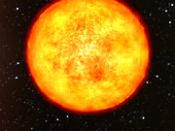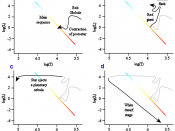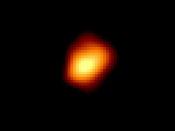Red Giant Stars
Red Giants are very large, cool and luminous stars. This stage lasts about 10% of the stars life. They are old stars meaning they don't have much lifetime left.
The red giant phase occurs in stars, which weigh less than 4 solar masses. The star starts to collapse towards the center causing the star to heat up. The fusion rate increases within the outer shells; this causes the star to expand. The surface cools, making the star turn red. The red color increases causing the star to increasingly expand.
Red giants occur as a result of the hydrogen in the core running out. This means that the hydrogen burning can only continue in the outer shells around the helium core. The core contracts under gravity until the temperature becomes high enough for helium to fuse to carbon and oxygen.
The helium in the giant star burns for around 10 million years.
When the helium runs out it continues burning in the outer shells. The star heats up causing carbon to turn to neon to sodium and then to magnesium. This lasts about 10 thousand years. Contraction and shell burning continues. Neon to oxygen and magnesium lasts 12 years. Oxygen to silicon and sulphur lasts 4 years, and silicon to iron takes 1 week.
As a red giant star the sun will lose a lot of mass due to weak gravity at the edge. The outer shells will become unstable causing contractions and variability. The star mass is too small for carbon fusion to occur, so the star collapses.
The sun will increase its luminosity by 10,000K. It will cool down to 4,000K and expands 200 radii. When the sun does eventually go through the red giant phase it will end up engulfing mercury, Venus and earth.


